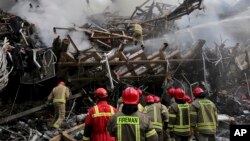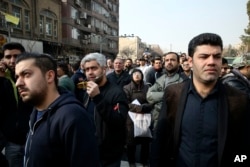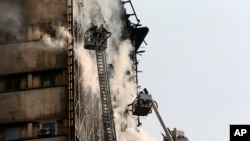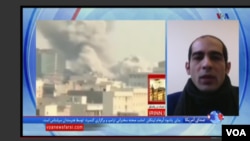Iranian rescuers have spent a second day trying to reach about 20 firefighters buried in the rubble of a Tehran high rise building as details emerge about the historic tower's poor state before it collapsed.
Iranian media said emergency crews were trying to locate possible survivors on Friday, using two tunnels dug into the wreckage of the 17-story Plasco building. Dozens of firefighters had rushed to the site on Thursday when a fire broke out at around 8am local time and quickly engulfed the more than 50-year-old complex, which housed hundreds of garment and clothing workshops. It collapsed three hours later in images broadcast live on Iranian television.
Authorities said no bodies had been pulled from the rubble 24 hours after the collapse, and around 20 firefighters were feared to have died. About 70 people were injured in the incident, including one firefighter who died of his injuries at a hospital on Friday. The early morning eruption of the fire on Thursday meant that few civilians were in the building at the time.
Iranian Foreign Ministry spokesman Bahram Qasemi said there was no damage to the German, Turkish or British embassies located near the site.
The semiofficial Mehr news agency said President Hassan Rouhani ordered his interior minister on Thursday to "immediately investigate the causes of the accident, identify those responsible, take care of the injured and quickly compensate people for their losses."
Mehr also quoted Iranian Supreme Leader Ayatollah Ali Khamenei as expressing deep sorrow for the collapse and saying "all efforts should focus on saving the firefighters trapped in the site." He added, "Finding causes and possible contributing factors is only a second priority."
Building history
The Plasco building opened in 1962 as the first high-rise tower in the Iranian capital. It was built by Habibollah Elghanian, a prominent Iranian Jew and businessman who was arrested on charges of being an Israeli spy and executed in 1979 during Iran’s Islamic Revolution.
The building originally was designed to house offices. But VOA Persian Service Executive Editor Mohammad Manzarpour, who visited Plasco in the late 1990s, said its configuration changed after the Islamic Revolution when a charitable foundation under direct control of Iran's then-supreme leader Ayatollah Ruhollah Khomeini took control of the site. He said Bonyad Mostazafan, or the Foundation for the Oppressed, rented out office space to the textile manufacturers and prevented the Tehran municipality from enforcing any safety regulations.
"I visited the building because my cousin had a T-shirt production line there," Manzarpour said. "It was horrific. The corridors were damaged and dark because the lighting was gone, huge parts of ceilings and walls were missing, and emergency exits were stacked with manufacturers' boxes."
Manzarpour, who previously worked as a journalist in Tehran, said the foundation did nothing when the municipality threatened to take it to court for ignoring warnings about safety at the Plasco building.
Soroush Farzin-Moghadam, an engineering professor at Worcester Polytechnic Institute in the U.S. state of Massachusetts, told VOA Persian's Newshour program that Iranian authorities typically attempt to update building codes when a disaster happens.
"But there's a double standard when it comes to implementation," said Farzin-Moghadam, who studied architecture and building technology in Tehran and has worked on residential complexes and airports. "When Iranian regulations do not deal with life and death issues, they are implemented completely, whereas when regulations do impact people's lives, they are ignored," he said.




